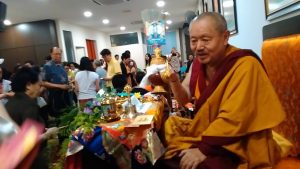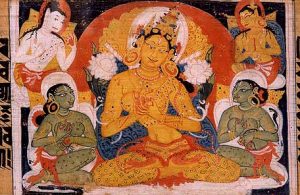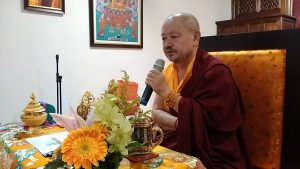The Empowerment of Prajnaparamita Heart Sutra
 The Great Mother of the Perfection of Wisdom or the Prajnaparamita is said to be the deity-embodiment or personification of the Essence of the Heart Sutra, a condense and potent discourse on emptiness or sunyata. In receiving this precious empowerment, one is said to have been prepared to be a vessel of transcendental wisdom by dissolving the Prajnaparamita into oneself. According to Khenchen Tsewang Gyatso Rinpoche, the pouring-in of the Prajnaparamita is akin to the absorption of nectar into our body.
The Great Mother of the Perfection of Wisdom or the Prajnaparamita is said to be the deity-embodiment or personification of the Essence of the Heart Sutra, a condense and potent discourse on emptiness or sunyata. In receiving this precious empowerment, one is said to have been prepared to be a vessel of transcendental wisdom by dissolving the Prajnaparamita into oneself. According to Khenchen Tsewang Gyatso Rinpoche, the pouring-in of the Prajnaparamita is akin to the absorption of nectar into our body.
In Praise of Prajnaparamita
Beyond words, beyond thought, beyond description,
Prajnaparamita is unborn, unceasing, the very essence of space,
Yet it can be experienced as the wisdom of our own rigpa (intrinsic awareness):
Homage to the mother of the buddhas of past, present and future!

When one is on the Vajrayana path, it is a standard practice for one to receive Wang, Lung and Tri (empowerment, oral transmission and instructions or teachings) from a qualified teacher. Khenchen is a pure preceptor of an authentic Nyingma lineage, which has started from the founder of Namdroling Monastery, H.H. Penor Rinpoche.
Many attend an empowerment session seeking for blessings, purification, protection and also for the removal of obstacles. While all these reasons are valid, Khenchen had skilfully advised that one must be vigilant because an empowerment is like a strong and powerful light that clears the obscurations that blind the realisation of our true Buddha nature. As such, the intended recipients should be listening to Dharma teachings. They must understand and apply the Dharma through learning, contemplation and mediation in order to effectively practice the Prajnaparamita.
After conferring the empowerment of Prajnaparamita to a group of attendees at Yayasan Pema Norbu Vihara, Khenchen Tsewang Gyatso Rinpoche proceeded to explaining the meaning of the Heart Sutra: the sacred text that espouses the dialogue on emptiness between Avalokiteshvara and Sariputra.
 As clarified by Khenchen, emptiness is neither nothingness nor does it mean that all phenomena are gloomy and nihilistic. Sunyata or emptiness refers to the nature of reality that goes beyond duality and the concepts developed by language. For example, a table is just a description of an object that is used to place things upon. A table does not exist per se on its own and inherently as an independent object. If we were to examine this thoroughly, the wood that is used to make the table was once a tree from a forest. At best, a table is a label; a concept that is verbalised in words to describe a physical object.
As clarified by Khenchen, emptiness is neither nothingness nor does it mean that all phenomena are gloomy and nihilistic. Sunyata or emptiness refers to the nature of reality that goes beyond duality and the concepts developed by language. For example, a table is just a description of an object that is used to place things upon. A table does not exist per se on its own and inherently as an independent object. If we were to examine this thoroughly, the wood that is used to make the table was once a tree from a forest. At best, a table is a label; a concept that is verbalised in words to describe a physical object.
Hence, Khenchen invites us to contemplate on this truth deeply as this will penetrate our ignorance of believing reality to be unchanging and permanent. It is akin to wanting our favourite song to play without the changing of notes and rhythm. We must bear in mind that a melody is composed based upon the principle of impermanence, that the shifting from one note to another creates a tune. Holding on to just one note creates noise. As the Buddha taught during the first turning of the Dharma wheel, suffering arises because of our grasping to an unchanging self that wants things to go our way and seeks greedily for power, authority and attention.
But by abiding in the spaceless space of the Prajnaparamita, we may then have a glimpse of the emptiness that is seen manifesting in the impermanence of the five skandhas (form, perception, feeling, mental formation and consciousness): from the changing seasons to the ever evolving trends in fashion and smart phones. And if we look within ourselves, we too are changing, aging and growing and it is this very observation of the ultimate truth that will give rise to the self-awareness of the transcendental wisdom, the Prajnaparamita.